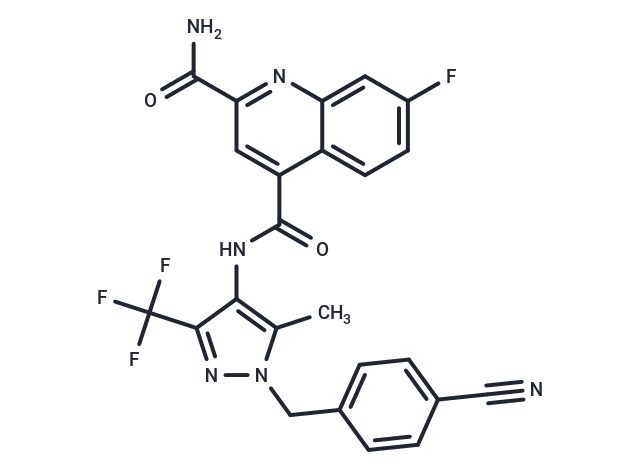Shopping Cart
Remove All Your shopping cart is currently empty
Your shopping cart is currently empty
BAY-876 is an orally active, selective inhibitor of glucose transporter 1 (GLUT1, IC50= 2 nM), exhibiting over 130-fold greater selectivity for GLUT1 than GLUT2, GLUT3, and GLUT4. It also inhibits glycolytic metabolism and ovarian cancer growth.

| Pack Size | Price | USA Warehouse | Global Warehouse | Quantity |
|---|---|---|---|---|
| 1 mg | $53 | In Stock | In Stock | |
| 2 mg | $75 | In Stock | In Stock | |
| 5 mg | $92 | In Stock | In Stock | |
| 10 mg | $141 | In Stock | In Stock | |
| 25 mg | $246 | In Stock | In Stock | |
| 50 mg | $371 | In Stock | In Stock | |
| 100 mg | $593 | In Stock | In Stock | |
| 200 mg | $839 | - | In Stock | |
| 1 mL x 10 mM (in DMSO) | $103 | In Stock | In Stock |
| Description | BAY-876 is an orally active, selective inhibitor of glucose transporter 1 (GLUT1, IC50= 2 nM), exhibiting over 130-fold greater selectivity for GLUT1 than GLUT2, GLUT3, and GLUT4. It also inhibits glycolytic metabolism and ovarian cancer growth. |
| Targets&IC50 | T24 cells:24.31 μM, GLUT1:2 nM, 5637 cells:21.62 μM, GLUT4:0.29 μM, EJ cells:18.72 μM, 786-O cells:53.56 μM, GLUT1:0.002 μM, GLUT2:10.08 μM, GLUT3:1.67 μM |
| In vitro | METHODS: HNSCC cell lines SCC47 and RPMI2650 were treated with BAY-876 (0.01-100 µM) for 24 h. Cell viability was detected by crystal violet staining. RESULTS: After 24 h, BAY-876 reduced the viable SCC47 and RPMI2650 cells. [1] METHODS: Ovarian cancer cells SKOV-3, OVCAR-3 and HEY were treated with BAY-876 (25-75 nM) for 24 h. The rate of glycolysis was detected by Glycolysis Assay. RESULTS: Incubation with BAY-876 dose-dependently decreased the rate of glycolysis in SKOV-3, OVCAR-3 and HEY cells. Although this anti-glycolytic effect of BAY-876 was detectable at single-digit nanomolar concentrations, half-maximal inhibition was achieved at 25-50 nM of the compound. [2] |
| In vivo | METHODS: To detect the antitumor activity in vivo, BAY-876 (1.5-4.5 mg/kg, 0.5% hydroxypropyl methyl cellulose and 0.1% Tween 80) was administered by gavage to NSG mice bearing SKOV-3 xenografts once a day for four weeks. RESULTS: BAY-876 showed a significant dose-dependent inhibitory effect on tumorigenicity. The maximum effect was observed in the 4.5 mg/kg/day treatment group. After 2 weeks of treatment, tumors were significantly reduced. At the endpoint, final mean tumor volume and tumor weight decreased by 68% and 66%, respectively, compared to the excipient control group. However, the dose of 4.5 mg/kg/day was toxic to NSG mice. [2] |
| Molecular Weight | 496.42 |
| Formula | C24H16F4N6O2 |
| Cas No. | 1799753-84-6 |
| Smiles | Cc1c(NC(=O)c2cc(nc3cc(F)ccc23)C(N)=O)c(nn1Cc1ccc(cc1)C#N)C(F)(F)F |
| Relative Density. | 1.48 g/cm3 (Predicted) |
| Color | White |
| Appearance | Solid |
| Storage | Powder: -20°C for 3 years | In solvent: -80°C for 1 year | Shipping with blue ice/Shipping at ambient temperature. | ||||||||||||||||||||||||||||||||||||||||
| Solubility Information | H2O: < 1 mg/mL (insoluble or slightly soluble) Ethanol: 3 mg/mL (6.04 mM), Sonication is recommended. DMSO: 257.5 mg/mL (518.71 mM), Sonication is recommended. | ||||||||||||||||||||||||||||||||||||||||
| In Vivo Formulation | 10% DMSO+40% PEG300+5% Tween-80+45% Saline: 1 mg/mL (2.01 mM), Sonication is recommeded. Please add the solvents sequentially, clarifying the solution as much as possible before adding the next one. Dissolve by heating and/or sonication if necessary. Working solution is recommended to be prepared and used immediately. The formulation provided above is for reference purposes only. In vivo formulations may vary and should be modified based on specific experimental conditions. | ||||||||||||||||||||||||||||||||||||||||
Solution Preparation Table | |||||||||||||||||||||||||||||||||||||||||
Ethanol/DMSO
DMSO
| |||||||||||||||||||||||||||||||||||||||||
| Size | Quantity | Unit Price | Amount | Operation |
|---|

Copyright © 2015-2025 TargetMol Chemicals Inc. All Rights Reserved.